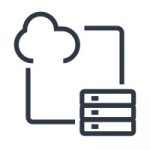A file server is a computer that stores files and documents for all computers connected on the same network. It acts as a central storage hub that allows users to access and share files without having to manually transfer them. They typically have large storage capacity and are equipped with many features to ensure data stays safe and available.
File servers make storing, securing and sharing files in an organization simpler. However, they are a common target for hackers and ransomware, so particular attention must be given to secure them against attacks.
How do file servers work?
Here are some basic uses of file servers:
- File storage: File servers have flexible storage capacities to store large files and documents in physical devices, like hard drives, or the cloud.
- Network connectivity: File servers are connected to the Internet and other computers in a network. File servers get assigned an IP address that you can use to remotely access the server.
- File sharing: A file server stores files in a shared directory or folders that can be accessed by multiple users. This makes cross-site collaboration and file transfers easier for teams.
- Security: File servers have security measures like user authentication, access control, encryption, anti-virus software, and regular updates that are critical to prevent data leaks and ransomware attacks.
- Data redundancy and backup: To protect against data loss, some file servers like Synology NAS devices can perform regular backups to external storage or the cloud and protect data using redundancy technology like RAID (Redundant Array of Independent Disks).
How can Synology NAS help with your business file management needs?
What is a NAS?
A NAS (Network Attached Storage) is a specialized storage device that connects to a network and provides storage and sharing capabilities to multiple users and devices.
NAS devices are versatile and can function as backup servers, virtual machine servers, surveillance servers, or file servers. As a file server, they offer centralized storage for multi-platform access, cross-site file sharing, data protection, and scalability. These plug-and-play devices are perfect for organizations handling large data volumes accessed by multiple users across different sites.
How can Synology NAS help with your business file management needs?
Synology NAS not only include centralized management solutions, but also enable collaboration with built-in productivity suites and features that simplify file management, such as:
See how organizations like Tourism Australia, the University of Washington, and the South African Institute for Aquatic Biodiversity use Synology NAS as a file server.
Learn more about Synology NAS integrated file management solutions:
 |  |  |
| File Server Efficiently store, access and share files with Synology NAS. | Multi-site Synchronization | File Transfer |
Most common file server protocols
File servers use different protocols to share files over the network. Each protocol offers different features, and these are the main ones used:
- SMB (Server Message Block): commonly used on Windows-based networks.
- NFS (Network File System): used for file sharing in UNIX and Linux-based systems.
- AFP (Apple Filing Protocol): used by Apple file servers to share files with Apple clients.
- FTP (File Transfer Protocol): used to transfer files over the Internet and between computer systems. Requires authentication for access, because the transferred data is not encrypted and vulnerable.
- SFTP (FTP over SSH): a secure version of FTP, which uses encryption to protect file transfers from unauthorized access or interception.
- HTTP (Hypertext Transfer Protocol): easy to implement as users only need a web browser to access files and is less prone to firewall issues (unlike FTP).
- HTTPS (HTTP over SSL): a secure version of HTTP. Just like HTTP, no installation is needed on the client side.
- WebDAVs (Web Distributed Authoring and Versioning): runs over HTTP, allowing users at different locations to exchange and collaborate on the same files.
Most common file server security measures
- Authentication: Use password, biometrics, or other methods to verify user identity.
- Access control: Permission settings to determine who can access which files and folders. This can prevent unauthorized users from accessing sensitive data.
- Firewall: A firewall can be configured to detect and block common network attacks, such as Denial of Service (DoS) attacks, port scanning, and intrusion attempts. It can provide logging and reporting services to analyze network traffic and security events.
- Encryption: Encode data to prevent unauthorized access. Encryption can implemented at the file level, disk level, or network level.
- Backup and recovery: Regular file backups ensure that files can be restored in case of accidental data loss. Follow the 3-2-1 backup strategy to ensure disaster recovery.
- Anti-virus and anti-malware software: Protects file servers against viruses and other malware that can compromise files and spread across the network.
File server vs. NAS
Flexibility
A file server provides more flexibility with operating systems and hardware components. You can choose among Windows, Linux, Solaris, FreeBSD, or other operating systems and upgrade the hardware components whenever you need. NAS is more plug-and-play compared to native operating systems, but memory and hard drives can be upgraded in most cases.
Scalability
File servers and NAS can both scale their capacity based on the number of hard drive slots (called bays) available on the devices. Both can also expand their storage by adding more file servers and NAS to expand system capacity. Some NAS can even expand capacity to SaaS to tackle the demand for additional storage and enable better collaboration for distributed teams.
Backup capabilities
In addition to file storage and sharing, some NAS can automatically create locally stored or remote backups of your files. In addition, some NAS include features that can be used to back up data from multiple sources at once, including computers, virtual machines, and SaaS, which is a big advantage over a file server.
Ease of use and maintenance
A file server is more customizable but it requires more technical knowledge to set up and maintain. A NAS is simple to set up and use, coming with a preinstalled operating system and extra features like intuitive interfaces.
Security
NAS usually have built-in security capabilities and are easy to configure for administrators because of the intuitive user interface. Whereas file servers typically require installation and configuration of security capabilities.
Lower cost
Price points vary depending on the system configuration and operating system employed. Overall, NAS can be a more cost-efficient solution for certain storage and data management needs when considering the additional features they have like mail solutions, collaboration tools, and surveillance software. Furthermore, NAS generally consume less power than file servers.
